The blind area around the house is a foundation protection that is designed to prevent soil erosion. The structure removes melt and rainwater from the foundation, thereby also reducing the load on the waterproofing. This increases the service life of both the foundation and the entire building as a whole.
For those who decide to make a blind area around the house with their own hands, it will be useful to know that the construction of the blind area is regulated by SNiP 2.02.01-83, taking these requirements into account, general calculations are made. The maximum percentage of the slope of the blind area should not exceed 10% according to SNiP III-10-75, and the deformation of the outer edge should not exceed 10 mm. The concrete used for the foundation pavement must meet the requirements of GOST 9128-97.
There are two main types of foundations around the house:
- Concrete blind area (classic);
- Soft.
![]()
Concrete blind area around the house
There is no need to spare money on the foundation area, since the service life will depend on the quality of the work done, and how much money will be spent on repairs in the future.
The construction of the concrete blind area consists of two layers:
- Underlying. For the sealing base, small crushed stone, sand and clay are used, the material is filled up with a thickness of 2 cm;
- Final. This layer includes fine cobblestones, asphalt and concrete, and is 10 cm thick.
Concrete blind area - step-by-step instructions for arrangement
- At the first stage, it is required to prepare and outline the area for laying, the recommended width of the blind area is 70 cm;
- The soil is removed along the perimeter of the building and then compacted. The depth of soil removal will depend on the width of the foundation blind area. For a concrete protective structure, a 25 cm excavation will be required, which is approximately the length of a shovel;
- Often, when removing the top layer of soil, you can find the roots of trees, they need to be treated with herbicides so that the blind area system is not damaged in the future;
- Using 20 mm boards, formwork is built so that the earth is compacted and no further subsidence occurs;
- The first layer is filled with sand;
- The second layer will be clay 10 cm high, after laying it needs to be well tamped and covered with the same layer of sand, water is used to seal the resulting structure. The sand, which is near the foundation, needs to be compacted very well, but you do not need to overdo it, since there is clay under the bottom;
- Crushed stone with a layer of 7 cm is laid on top of the clay;
- With a step of 10 cm, using a mesh, the structure is reinforced to strengthen the blind area. The concrete blind area has good indicators of tensile and compressive loads;
- It is required not to forget about the expansion joint at the junction of the basement and blind area during the construction of a protective system. The presence of a seam will allow in the future, when the soil subsides, not to collapse the blind area of \u200b\u200bthe foundation and the basement. The expansion joint is 1.5 cm and when the blind area subsides, both the protective structure itself and the base will not be damaged, with the help of bitumen, sand and gravel the resulting gap is filled;
- At the last stage of the construction of the blind area, concrete is poured.

Soft blind area - features
An attractive appearance of a soft blind area, much better than a concrete structure, but here, during installation, you need to be very careful so that beauty does not harm the foundation. The soft blind area consists of two layers: the upper one is decorative, it completely lets water through, which enters the lower layer on the waterproofing film. In the classical construction, the properties waterproofing film performs concrete.
Soft blind area construction technology
Sequential algorithm:
- Clay is laid as the bottom layer over the entire width of the blind area with a slope of 10 cm. The clay must be clean, without any admixtures of sand, since otherwise the protective structure of the foundation will swell. At 10 cm, the material is laid, followed by compaction and leveling;
- The waterproofing film is installed on top of the clay and fixed on the surface of the foundation with a margin of 3-4 cm around the entire perimeter of the foundation. This will contribute to the integrity of the structure, even if the blind area moves away from the foundation. It is forbidden to use roofing material as a waterproofing material, since it is not durable;
- The next 5 cm layer will be sand, it serves as a waterproofing protection;
- Geotextiles made of propylene filament are laid along the entire width, the material prevents sand from entering and passes water well;
- Crushed stone is laid with a layer of 12-15 cm on top of the textile, which allows moisture to penetrate before waterproofing, and then flow away from the foundation system;
- Geotextiles are re-laid on crushed stone and then finishing takes place.

The material for finishing the blind area can be:
- decorative concrete;
- a natural stone;
- tile;
- paving stones and so on, all at the discretion of the owners of the country house.
The design of the soft blind area will significantly increase the life of the foundation, since it is not afraid of moisture and negative temperatures.
Blind area insulation technology
Several building materials can be used as thermal insulation for a soft foundation blind area:
- Polyurethane foam;
- Extruded polystyrene foam.
Often, when installing a soft blind area around the house, extruded polystyrene foam is used, since this material has high strength rates, zero capillarity, easy installation and processing, a long service life and is an environmentally friendly product.
Insulation with expanded polystyrene occurs in 1 layer with sheets of 100 mm or 2 sheets of 50 mm. Polyethylene is installed on top of the insulation material, for increased protection at the joints.
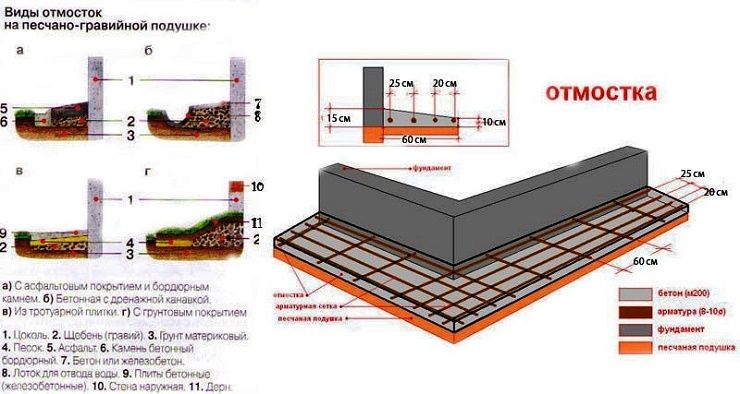
Repair of the concrete blind area
If the technology for the construction of the blind area and foundation was followed, then the repair of the structures will not take very long and problems should not arise. But sometimes cracks form on the blind area, there are several ways to eliminate it:
- Small cracks are eliminated with cement mortar 1: 1;
- Large damage to the blind area is cut and cleaned, and then filled with mastic: BND-90/130 70% bitumen. Cracks filled with mastic are strewn with sand on top;
- In case of significant damage to the concrete blind area around the house, repairs must be carried out with fresh concrete. The surface of the structure is cleaned and primed with 1: 1 cement mortar. And while the concrete is not frozen, it needs to be leveled.
Repair work to eliminate cracks in the foundation blind areas is recommended to be carried out in cool weather when the concrete does not expand. Otherwise, in sunny and hot weather, the seams will narrow, which will not allow high-quality repairs to the foundation blind area.
One of the main elements of the house is the foundation, which provides support for the walls, the absence of distortions and vibrations of the building. For a long service of the foundation, it is necessary to protect it from harmful environmental factors with a blind area.
In contact with
The main tasks of the blind area:
- drainage of rain and melt water from the foundation into the drain;
- protection of the soil near the foundation from freezing;
- attractive appearance.
Blind area must be installed as soon as possible after completion of the roof construction, from this moment on, the largest amount of water begins to flow to the foundation. It should be installed before the onset of the winter period to prevent melt water from freezing near the foundation, which negatively affects the strength of the entire building. Before starting construction, it is necessary to consider the device and size of the blind area around the house.
Device blind area at home
Allocate two mandatory components of the blind area:
- underlying layer (below);
- coating layer (top).
The underlying layer is a flat compacted base, on top of which the covering is laid. Most often, sand, clay, fine gravel are chosen as materials. From this list, only clay has a waterproofing property. The substrate material is selected depending on the type of coating. The underlying layer is, on average, 20 cm thick.
Waterproofness and resistance to water erosion are the main criteria for choosing a coating. Concrete, small cobblestone, asphalt, clay, sidewalk slabs are most often used as coating materials. The thickness of the coating is about 5-10 cm and depends on the type of material used.
It is possible to use a combination of coating and sub-base, for example the use of clay mixed with sand or gravel.
The main regulatory document governing the arrangement of the blind area is the "Manual for the design of the foundations of buildings and structures" (to SNIP 2.02.01-83), paragraphs 3.182 and 4.30.
Blind area technology includes several important points:
- Between the wall and the blind area, it is necessary to leave a 1-2 cm gap, which is filled with expanded polystyrene or quartz sand. Otherwise, subsidence of the coating may occur, which will damage the base of the foundation.
- It is necessary to create a slope to divert water from the building. It is formed when compacting the soil or in the very process of laying the coating.
- The choice of materials affects the height of the basement plinth. When choosing crushed stone or gravel, its height should be at least 30 cm, when using concrete or paving slabs - more than half a meter.
- The device is regulated by the HESN, when using the pavement as a pedestrian zone, which is referred to as road-asphalt pavements, as indicated in the regulations. The rates also indicate material costs and labor costs.
- Indicated minimum width blind areas of the building: on soil subject to shrinkage, it will be at least 2 meters, on solid soil - 1 m.
The price of work and the device of the blind area will be determined in accordance with the UNIR in the implementation of work by state organizations, mainly it changes only from the type of components used.
Basic types of structures
![]() Depending on the material used, see below.
Depending on the material used, see below.
Concrete blind area
The surface makes the blind area waterproof. This method is the most common due to its ease of implementation and availability.
Styling features:
- It is necessary to lay the lower underlying clay layer (15 cm) and sand (8 cm), which play a cushioning role.
- To prevent cracks from appearing in cold weather, expansion joints must be provided before placing concrete. To do this, place guide rails every 3 meters, located across the platform, the top of which should be level with the cement mortar. They are guided by them when leveling the concrete mass.
- The wet layer is covered with cement in several passes, then smoothed out.
- It is advisable to use concrete reinforcement to increase the service life. Steel mesh is used.
Soft blind area
Its advantages are its beautiful appearance, the ability to perform the functions of the sidewalk.
Styling features:
- It is necessary to lay the lower clay layer (15 cm), then tamp and level it. The absence of sand in the layer is important, otherwise there is a high probability of the entire structure swelling.
- A waterproofing film is applied over the clay layer. Important note - you cannot use roofing material.
- Laying a layer of sand (5 cm).
- Geotextile is laid on top, a feature of which is the transmission of moisture, while there is no likelihood of filling the void with sand between the drainage components.
- Laying a 12-15 cm layer of crushed stone, which serves as a drainage, water passes through it to the waterproofing layer, and then is diverted away from the building.
- Laying the second layer of geotextile.
- Backfilling of the second layer of sand (5 cm).
- A special coating that is resistant to temperature and humidity, with a beautiful appearance.
Blind area from paving slabs (paving stones)
The blind area has an attractive appearance, it can serve as a walking path.
Advantages:
- resistance to cold and heat;
- a variety of tile shapes;
- large selection of colors;
- the ability to combine different colors and shapes to create an ornament.
Paving stones are made of concrete or stone (granite, basalt). Stone tiles have a limited range of shapes.
Styling features:
- A layer of clay is laid (about 10 cm).
- Covered waterproofing material, which is attached to the wall with its edge using a metal strip.
- A sand layer is laid out (15 cm).
- The sand layer is covered with tiles.
- The gaps between the tiles are filled with sand.
Sidewalk slabs
The advantage is the simple replacement of worn out elements. The slabs are laid on top of the concrete base. Process preliminary preparation the soil does not differ from the above.
There are square and rectangular different sizes. According to the type of material, slabs are divided into reinforced concrete and stone. On the surfaces there may be notches, reliefs that serve as decoration.
Crushed stone blind area
The simplest type of blind area. It is used when there is a high level of groundwater and when it is necessary to perform drainage around the building. Crushed stone can be replaced with pebbles, expanded clay, gravel. Geotextile is applied to the compacted soil, a layer of crushed stone about 10 cm thick is poured over it.
Dimensions of the building blind area
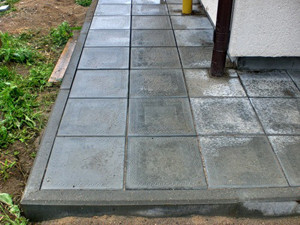 According to SNiP blind area width around the house there should be at least 30 cm more overhang of the roof and at least 60 cm. It should be taken into account whether the blind area will perform additional functions, for example, it will be a pedestrian path. In this case, it is recommended to make the width at least one meter for the convenience of people passing. You also need to consider the type of soil. For sinking soils, the width should be more than 90 cm.
According to SNiP blind area width around the house there should be at least 30 cm more overhang of the roof and at least 60 cm. It should be taken into account whether the blind area will perform additional functions, for example, it will be a pedestrian path. In this case, it is recommended to make the width at least one meter for the convenience of people passing. You also need to consider the type of soil. For sinking soils, the width should be more than 90 cm.
Blind area thickness depends on the types of material used for its manufacture. On average, the depth to which you need to go deeper is 25-30 cm.
Blind area slope should be at least 1.5-2% of the width. Do not make this indicator less, the water will not drain well and stagnate near the foundation, which will lead to its destruction. The angle also depends on the type of coverage. For crushed stone and stone, 5-10% is recommended, for concrete and asphalt coatings - 3-5%.
A gutter should be placed around the perimeter of the blind area. It can be done with a recess in concrete or as a half pipe set on concrete base.
In the place where the blind area connects to the wall, it is recommended to leave an expansion joint... The joint width is approximately equal to 1-2 cm. The joint can be sealed with sand, bitumen or two layers of roofing material, which is preferable. It is impossible to connect the wall to the blind area end-to-end, this can lead to damage to the facing material.
The concrete from which the foundation is made has a high thermal conductivity. If a basement or basement floor is provided, it is recommended to insulate the blind area, for example, with extruded polystyrene foam (EPS). The insulated blind area will significantly reduce the heat loss of the building, which will reduce heating costs in the cold season.
Before laying blind areas of any kind, it is necessary to carefully remove vegetation from the working area. Vegetation reduces the quality of soil compaction, retains moisture and can damage the structure over time.
The blind area protects the foundation of the house, protecting it from moisture. However, it is often part of the decorative arrangement of the entire yard. The selection of materials for the blind area should take into account not only functional features, but also compatibility with the design elements of the site: paving slabs, an access road, a fence and decoration of the house itself.
therefore it is worth planning the device and design of the blind area in advance, at the stage of development of drawings, so that the architectural ensemble of the site looks holistic and complete, and the whole structure of the building remains strong for many years.
installation of a blind area at home SNIP ENIR technology price
In contact with
Do you see inaccuracies, incomplete or incorrect information? Do you know how to make your article better?
Do you want to offer photos on a topic for publication?
Please help us make the site better! Leave a message and your contacts in the comments - we will contact you and together we will make the publication better!
When erecting any building after the completion of all construction and external finishing works it is necessary to make a blind area. This coating on the surface of the earth along the perimeter of the building protects the base from erosion by surface sediment and melt water flowing down from the roof and other above-ground parts of the building. The design, width, height and slope of the coating are strictly regulated by regulatory documents (SP, SNiP and GOST). From our article, you will not only find out what a blind area is, but after reading it, you will be able to perform it according to all the rules, relying on the norms of SNiP and SP.
Concept and features
The blind area is an important structural part of the building, which runs as a continuous covering around the perimeter of the entire structure
Do not think that the arrangement of the blind area around the house has only aesthetic functions. This is an important structural part of the building, which runs as a continuous covering around the perimeter of the entire structure. The width of this product is standardized by SNiP with marking 2.02.01-83.
Important: the blind area is done after the whole house is built and the exterior finishing work is done.
The device of the blind area according to the joint venture must be completed before the onset of cold weather. To perform this coverage around the building, you can use several types of materials used for road pavements in accordance with GOST:
- concrete is the most accessible and common material that is often used in individual construction;
- paving slabs;
- asphalt.
There is another type of blind area, called hidden. In this case, at first glance, it seems that the green lawn or sidewalk is adjacent to the house. But under it, at a shallow depth, a hidden concrete blind area is made, which protects the base of the house no worse than surface coatings.
According to the joint venture, the main functions that this product performs around a residential or industrial building are as follows:
- The aesthetic role of the blind area is undeniable, because thanks to the neat strip of coverage around the house, the entire structure looks neat and finished.
- The main role of this structural part is protective. That is why the basic parameters in the joint venture, GOST and SNiP are so strictly standardized. Thanks to the protective coating, melt and sedimentary waters cannot wash away the soil under the house and come into contact with building structuresslowly destroying them. In addition, the product protects the foundation from destruction by the root system of trees.
- The blind area helps to keep warm in the basement and the house. The thing is that the soil under the blind area will not freeze deeply, and therefore, heat will remain in the basement, which will not allow the floors on the first floor to be cold.
- The joint venture stipulates the protective function of the blind area from rock swelling. If the soil around the building does not freeze as deeply as before, then the forces of frost heaving will not affect underground structures grounds.
General requirements
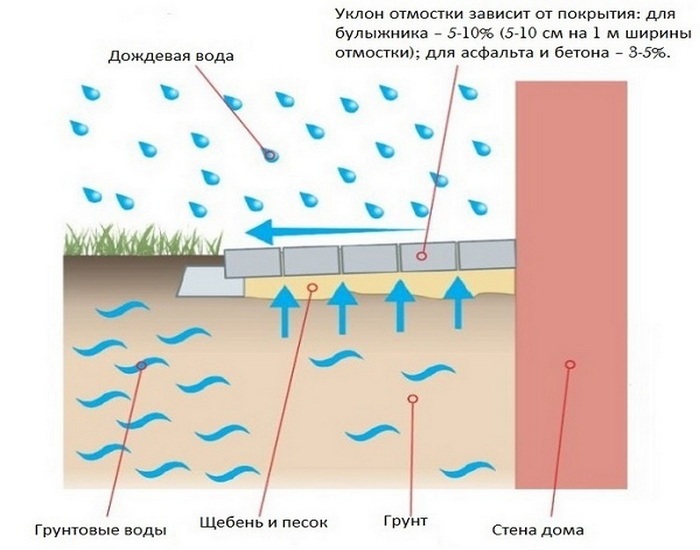
What is the blind area, we figured it out, now let's talk about the requirements for it. When manufacturing a protective coating around a building, it is necessary to be guided by regulatory documents (SP, SNiP and GOST). In them you can find general requirements to perform the blind area:
- This continuous continuous coverage must extend around the perimeter of the entire structure.
- The width of the blind area is strictly standardized, which should be at least 200 mm more than the overhang of the roof.
- By increasing the width of this cover, the degree of protection can be increased. Optimal width can be determined based on the rules of the code of practice (SP).
- The cover is made with a slope from the building to ensure the drainage of surface water from the structure. The slope is standardized by SNiP.
- A temperature gap of 2 cm is made between the coating and the cladding of the basement of the house. It will not allow the coating to press on the structures of the house in winter. To prevent moisture from seeping into the gap, it is filled with sealant.
Design
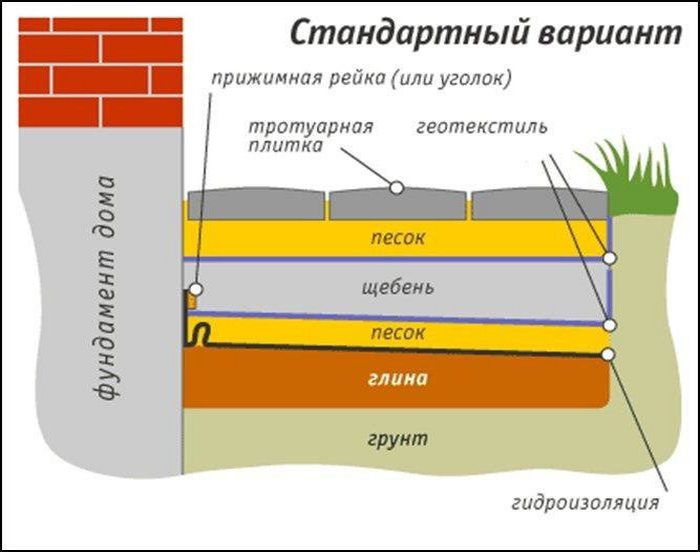
- base, which is made of a layer of sand and an interlayer of gravel or crushed stone;
- protective coating made of paving slabs, concrete or asphalt.
The height of the underlying layer according to the joint venture should be at least 20 cm. The height of the protective layer depends on the material used and can be about 10-15 cm. To increase the protection of the base of the building from moisture, a clay castle is made under the blind area.
Important: any blind area, be it concrete, asphalt or slab construction, must have a dense waterproof structure.
Cover width
![]()
According to SNiP, the minimum width of the blind area is 1 m.More precisely, this indicator is determined taking into account the subsidence of the soil around the house. The degree of subsidence of clayey soils can be different. This value can be determined only in the laboratory. In general, according to SNiP, two types of soils are distinguished, depending on their subsidence:
- rocks in which subsidence is completely absent or is no more than 50 mm (soil subsidence can occur only under external influences);
- in rocks of the second type, subsidence from their own weight is allowed (at the same time, they will also sink from external loads). The amount of subsidence for rocks of the second type exceeds 50 mm.
According to the data on the subsidence of the rock, the width of the blind area is selected:
- for soils of the first type, the width of the cover around the building should be at least 150 cm;
- in the second case, the width of the cover should not be less than 2 m.
Important: when building on soils with normal bearing capacity the minimum width of this coating can be in the range of 0.8-1 m. However, it should be borne in mind that this value should exceed the roof overhang by 20-30 cm.
As for the height of this protective coating, it is stipulated by the norms that it must rise at least 50 mm above the zero mark. When constructing a pedestrian blind area, additional requirements are imposed on the structure with respect to strength and overall dimensions.
Bias
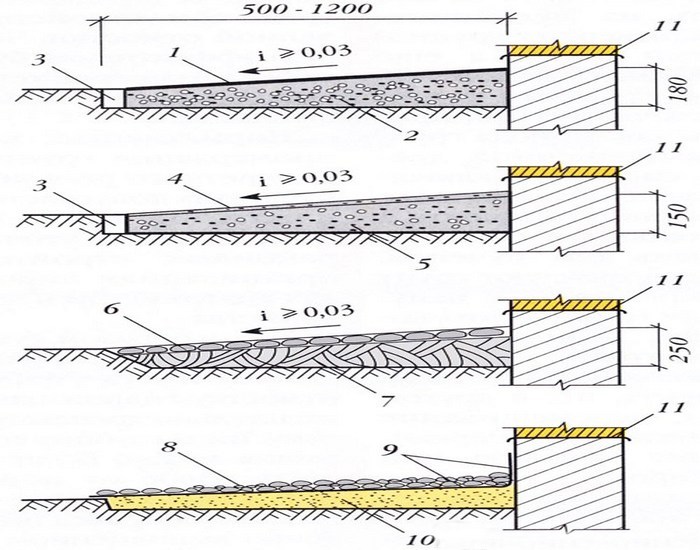
According to the joint venture, the slope of the blind area should be at least 10 ppm from the structure. In other words, the slope is 10 mm per 1 m of width. To ensure effective drainage of surface water from the building, the slope is increased to 20-30 mm per 1 m of width.
The maximum slope of the blind area is also normalized. It should not exceed 100 mm per meter. A too steep slope will cause the rapidly flowing water to erode the outer edge of the pavement and cause it to gradually collapse.
Occasionally, water intake gutters are laid along the outer edge of the coating. They follow the contour of the blind area with a certain slope, which contributes to the drainage of sediment and melt water from the walls of the building directly into the storm sewer system.
Concrete blind area manufacturing technology
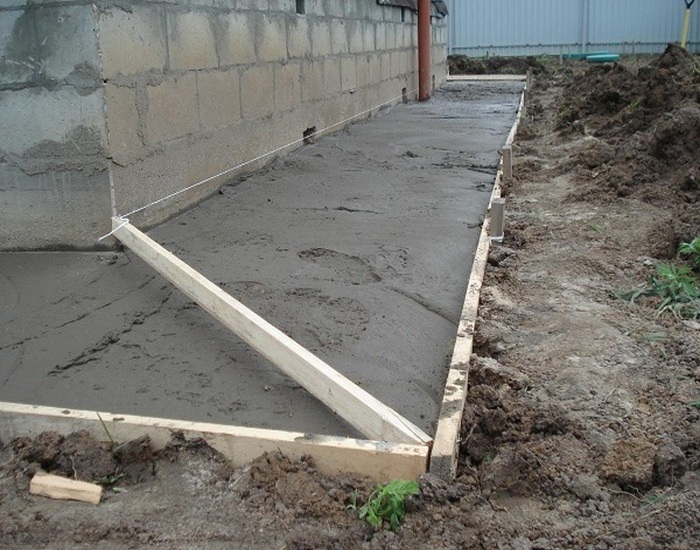
Since in private construction most often the protective coating around the house is made of concrete, we will take a closer look at the manufacturing process:
- First of all, the area around the house must be marked out and pegs must be driven into the corners of the future covering.
- Then a layer of soil 25 cm high is removed along the perimeter of the building. This depth is optimal for a blind area made of concrete. If you use other materials, this value may be different.
- To prevent plant growth, the soil is treated with herbicides.
- Next, along the edge of the ditch, we install the formwork from shields or boards.
- The soil at the bottom of the ditch must be well compacted. Lay a layer of clay on top of it to further protect the underground structures from moisture.
- After that, we make a sand layer 10 cm high. Wet the sand with water and ram.
- Then backfill is made from rubble. Layer height 60-70 mm.
- To make the concrete easily withstand tensile and compressive loads, we lay a reinforcing mesh.
- At the point of contact of the blind area with the plinth, we equip an expansion gap. This seam is needed to protect against deformation in case of shrinkage of a particular part of the structure. The expansion gap width is 10-15 mm. To prevent moisture from entering the seam, mastic, bitumen or several layers of roofing material are laid there.
- Now let's start pouring concrete. We level the surface. So that during the cold weather the concrete does not crack, it is necessary to perform expansion joints. For this purpose, with a step of 2-3 m, wooden slats are installed in the same level with the concrete surface. In this case, the slats are mounted with the required slope from the walls of the building. Thus, they will allow you to control the pouring of concrete with the desired slope.
- The first week in the hardening process concrete surface need to be moistened with water to prevent it from drying out.
Also, the normative documents regulate the concrete grade for frost resistance. To carry out these works, you can use concrete of at least 200 grade. To control the slope of the blind area during the manufacturing process, it is worth using a level or level.
In addition to the method described above, the desired slope of the blind area can be given as follows:
- Create the required slope when backfilling the first subbase of sand and gravel. For this, more material is poured near the walls of the building.
- First, a more liquid concrete is poured, it is leveled into a horizontal plane itself. After it hardens, a thicker concrete composition is prepared, which is laid out on top of the first layer with a slope along the installed wooden slats. The slats are attached to the formwork.
The quality of the various constituent elements of the house largely depends on the structures that directly adjoin them and perform a number of imperceptible, but very important functions.
The blind area is a strip of various materials located around the entire perimeter of the building and adjacent at a certain angle to its walls. The life of the foundation and the general microclimate in the basement and basement floors depend on the quality of the erected blind area.
In this article, we will try to consider the general arrangement of the blind area and stepwise process her arrangement.
Why is the essence of construction needed
Blind area - device and construction technology
The blind area, as mentioned above, is important and performs a number of functions:
- Protection of the foundation from moisture, rainfall and groundwater;
- Affects the microclimate in the basement and basement;
- Does not give foundation subsidence around the perimeter of the structure;
- Decorative element;
- In some cases, it serves as a sidewalk sidewalk.
As a rule, the arrangement begins after or during the cladding of the walls and the basement of the supporting base. This process should not be postponed for some time, since after several years, especially in areas with a high degree of precipitation, flooding of the foundation can significantly reduce its strength.
In the absence of a blind area, in winter and during the cold season, due to freezing of the soil, the soil swells and presses on the concrete base and walls. Subsequently, this leads to the appearance of cracks or destruction of the supporting structure.
General structure and components
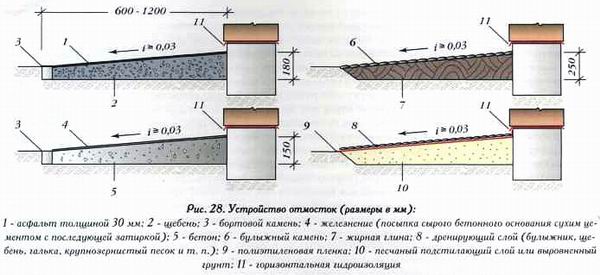
The device of any blind area of \u200b\u200bthe foundation is a "building cake", consisting of at least two layers: an underlay and an outer coating.
- The base or sub-base is a compacted material laid on top of the ground or waterproofing. For the base, both ordinary sand or crushed stone can be used, as well as clay, which will serve as additional insulation. As a rule, the thickness of the underlying layer does not exceed 30-40 cm. The material is taken depending on the coating used.
- The outer coating is a material that prevents moisture from penetrating into the blind area and prevents it from eroding. For this, a concrete-cement screed with the addition of gravel, asphalt or paving slabs is usually used. The thickness of this layer must be at least 10 cm.
Required width and slope of the structure
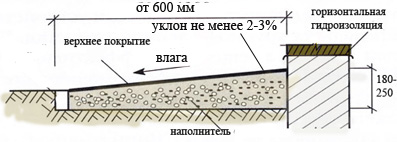
Diagram of the device with the required width and surface slope
The width of the blind area, first of all, depends on the distance over which the edge of the building's roof protrudes. The minimum required width ranges from 60 to 80 cm and depends on the type of soil on which the structure will be erected.
For stable soil types, the width should not go beyond the roof edge by more than 20-30 cm. If the soil layer is unstable, then the width can be increased to 90-120 cm. Further increase practically does not play any role.
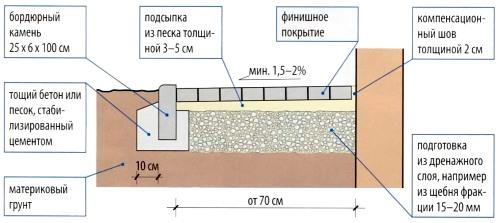
General arrangement scheme
If the blind area also serves as a footpath, then its width may well be 1.5-2m. The main thing is to monitor the overall composition of the building so that the dimensions of the structure are in harmony with other elements of the building.
The slope depends on the coating used for the outer layer. For most concrete structures, a slope of 4-5% is sufficient. For a crushed stone or gravel blind area, it is recommended to make a slope of at least 5-7%.
Device and technology of work
The general arrangement of the blind area can be reduced to the following main stages:
- At the first stage, it is necessary to excavate the soil to the width and depth of the future blind area. It is recommended to treat the dug trench with special means to remove plant roots.
- Formwork from a wide board is installed along the perimeter of the trench. Small concrete blocks or curbs can be used as formwork.
- A layer of bedding material is laid at the bottom of the trench and carefully compacted. It is advisable to lay the material in such a way that part of the sheet goes slightly onto the wall of the base. This is necessary to create an expansion joint between the blind area and the wall.
- On top of the inner layer, a coating of various materials is laid in several layers.
This completes the general device, but for each type of material used to create the outer layer, there is its own installation technology:
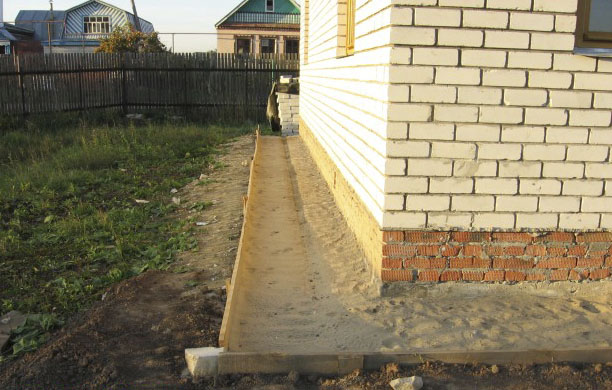
Prepared sand base and exposed formwork on the outside
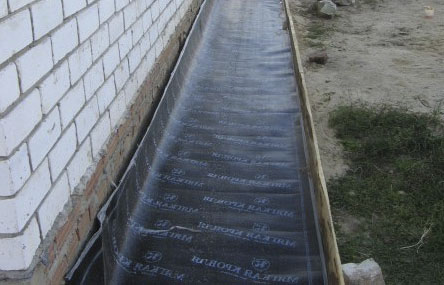
Seams are placed perpendicular to the walls of the building with a step of 2-2.5 meters. The slats can be used as guide beacons for distributing concrete over the surface of the blind area.
After laying the concrete, the wet surface of the foundation blind area must be additionally sprinkled with cement and smoothed with a trowel. This process is called ironing and is necessary to increase the moisture resistance of the concrete. After that, the finished structure is covered with a fabric material and periodically moistened with water until the concrete sets completely.
For concrete structureslocated on unstable and heaving soils, it is recommended to carry out reinforcement. This is done to increase the service life by laying a metal mesh with cells of 10 by 10 centimeters before pouring concrete.
The technology is quite simple and does not require the involvement of specialists. The main thing is to carry out the work in stages and adhere to the basic installation rules.
Sealing the structure
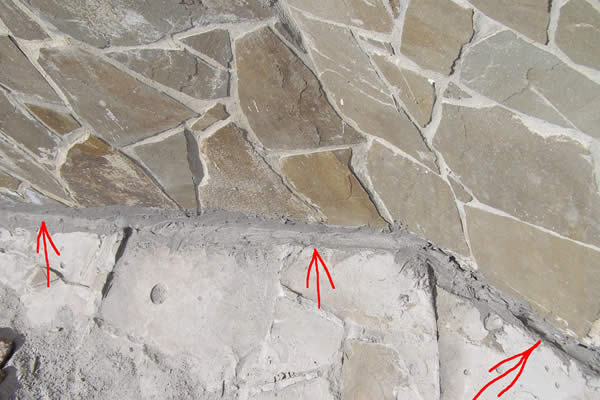
Sealed expansion joint
Sometimes, in houses located on heaving soils, a crack may appear between the basement and the surface of the structure.
This can be done both at the stage of the device and subsequently in operation. In the first case, the following options are possible:
- The structure should be made on a drainage base in the form of sand, gravel and clay;
- The lower part of the blind area should be higher than the soil around the building;
- The expansion joint must be made in such a way as to maintain tightness between the blind area and the basement wall.
Failure to comply with these conditions, as mentioned above, may result in a crack or structural departure from the building. If this happens, then special polyurethane-based sealants are used. The resulting crack is filled with a sealant using an assembly gun.
To protect against mold and mildew, the seam is treated with a water repellent.
Thermal insulation of the structure

Thermal insulation with foam and mesh reinforcement
Insulation should be carried out when erecting a structure on unstable types of soil. Insulation will help prevent soil from freezing, thereby preventing soil swelling.
For this use thermal insulation materialsthat are laid on top of the underlying layer. It is desirable that the outer covering is made of concrete or paving slabs, as this will help to avoid additional stress on the thermal insulation material.
For common and simplest thermal insulation, we recommend using extruded polystyrene foam or foam.
Construction repair
In case of obvious damage to the outer layer of the blind area, it should be repaired as early as possible in order to avoid further destruction. To do this, the damage boundary is determined so that the main cracks or potholes are combined into a common plane that can be removed.
Proceed to repair work better in cool weather, when the main damage is most exposed under the influence of absorbed moisture.
If the asphalt pavement is damaged, it is necessary to remove a layer of material from the desired area to the full depth. After removing the damage, it is recommended to clean the pits from dirt and coat with bitumen.
Only then can the asphalt concrete be re-laid and compacted. It is desirable that the new asphalt cover the old pavement. This will give better grip on old material.
Bituminous mastic and cement-sand mortar are used. Cracks are cleaned of dirt and filled with mastic. Small damages can be covered with cement mortar mixed in proportions of 1/1.
There is nothing secondary in construction. To all structural elements buildings and structures must be approached responsibly.
One of the final types of work on a construction site is the installation of a blind area. It is carried out at the end of the construction of the house, in parallel with the construction of an external staircase or an entrance to the garage, but after the facade of the building or at least the basement has been finished.
Blind area - a strip 0.6-1.2 m wide, adjacent to the foundation or basement of the building with a slope, "descent" from it. The slope of the blind area should be at least 1% (1 cm per 1 m) and no more than 10% (10 cm per 1 m).
Do you need a blind area?
The main task of the blind area is to drain surface "rain and melt" water from the walls and foundation of the house. The blind area prevents the penetration of surface water to the base of the foundation, and is also decorative element external improvement, forming a sidewalk around the house.
In addition, the blind area does not allow the lawn or plants to grow close to the walls of the house, preventing excessive moisture in its structures and damage to the foundation by the roots of trees and shrubs.
Blind area design
The traditional blind area consists of two main layers - a decorative coating and an underlying layer.
Underlying layer
The underlayment serves to create a compacted and even base for further laying of the blind area cover. As an underlying layer, it is used: sand, crushed stone, clay... The choice of material depends on the top cover of the blind area.
Decorative coating
The covering of the blind area should be primarily waterproof and difficult to be washed out by water.
In the old days, the blind area was made of clay: they dug a shallow trench around the perimeter of the house and filled it with clay, which was tamped with a slope away from the house and moistened, creating a waterproof layer on the surface of which rain and melt water flowed down.
Today, when constructing a blind area, clay is replaced with concrete - it allows you to get a monolithic surface without cracks, which is especially important when there is no confidence in the presence of foundation waterproofing. If the foundation is properly insulated, then piece materials can be used for arranging the blind area - paving slabs (paving stones), crushed stone, slabs.
Blind area device
Blind area level
The height of the basement depends on the type of material from which the blind area is made. If it is gravel or crushed stone, it is enough to raise the basement to a height of 30 cm.If it is a hard and flat surface (for example, concrete or paving slabs), the height of the basement must be increased to 50 cm.
Blind width
The width of the blind area is set depending on the type of soil and the removal of the eaves of the roof. On ordinary soils, the width is taken 20 cm wider than the cornice (but not less than 60 cm) so that the water flowing from the roof does not erode the soil and does not stagnate under the house. On collapsible soils 20-30 cm beyond the slopes of trenches or pits, torn off under the foundation, but not less than 90 cm.
Blind area slope
For cobblestone and crushed stone pavement, the transverse slope from the axis of the house is taken within 5-10% (5-10 cm per 1 m of width). For concrete and asphalt 3-5%. Moreover, the steeper the slope, the better the water is drained away and the more inconvenient the blind area becomes as a walking path around the house.
The gap between the wall and the blind area
When constructing a blind area, you should remember about the gap between it and the wall. Its purpose is to protect the basement walls from damage and destruction. If there is no gap, then under the influence of frost, the blind area made of paving stones or slabs will exert pressure on the wall, and as a result of walking on it, it will settle and damage the insulation on the outer surface of the foundation wall. The cladding material may also be damaged, for example, tiles on the plinth peel off.
To prevent this, a 1-2 cm expansion joint must be left and filled with sand, extruded polystyrene foam or sealant.
Drainage around the blind area
Only a blind area of \u200b\u200b3 or more meters wide can guarantee a complete drainage of water from the foundation and its "dry mode", which of course is not always realistic to do, therefore it is worth applying additional protection - a stormwater and drainage device.
For rigid blind areas such as concrete and slabs, surface linear drainage is suitable - a drainage groove or gutter along the outer line of the blind area made of stone, concrete, plastic or asbestos-cement pipes, cut in two along the length. And don't forget about their slopes!
Ready-made drainage elements, complete with upper protective gratings (plastic or polymer concrete), are good. Ready-made drainage trays with a drain pipe and an upper grate, adapted for installation in the prepared plane of the foundation blind area.
Blind area of \u200b\u200bpaving slabs
(paving stones)
One of the most commonly used blind area materials - concrete paving... It is resistant to frost and temperature changes. Paving stones are available in different colors and shapes: rectangle, square, hexagon, wave, etc. The edges of the paving stones can be flat or chamfered, which significantly reduces the risk of edge chipping. Paving stones are produced with a thickness of 4-10 cm, a width of 6-20 cm and a length of 10-28 cm. For the installation of a blind area, elements with a thickness of 4-6 cm are most often used.
Stone paving is an natural material and in comparison with concrete does not have such a variety of shapes. Usually it is a cube or parallelepiped made of gray, red or yellow granite, as well as black basalt. Of course, it costs much more than concrete counterparts.
Laying the blind area
Before starting work on the installation of the blind area around the building, all work must be completed, the performance of which may lead to damage to the blind area, namely:
- a roof, eaves and canopies over the entrances have been arranged;
- covered with metal plums of window openings;
- all downspout fittings and fire escapes are installed.
Pegs are hammered in the corners of the building, on which they mark the height of the junction of the blind area to the basement, and according to these marks, the cord is fixed along the entire perimeter of the building. A second line of pegs is installed along the outer edge of the blind area. They mark the height of the outer edge of the future concrete cover of the blind area.
To drain rainwater, the blind area is performed with a slope (at the base, the thickness of the coating is 15 cm, and at the opposite edge 10 cm). The transverse slope from the basement of the building is - 5% (5 cm by 1.0 m wide).
First of all, it is necessary to determine the width of the blind area, which depends not only on the wishes of customers. This parameter is largely determined by the type of soil and the width of the roof eaves overhang. On ordinary soils, the blind area should be 20 cm wider than the eaves overhang (its minimum width is 60 cm). In the event that the building is built on subsiding soils, the width of the blind area should be at least 90 cm. Sometimes it is made 1.0 m wide or more - in this case, the blind area, as a rule, serves as a path around the house.
The construction of the blind area begins with the removal of vegetation around the house and the removal of the vegetation layer to a depth of 15 cm. The remnants of the roots are carefully removed so that in the future the sprouts that have broken through do not destroy the coating.
Along the stretched twine, indicating the longitudinal line of the edges of the blind area, a rectangular trench (trough) is manually torn off to arrange the base for the blind area. The bottom of the trough is compacted.
On the prepared bottom of the trough, crushed stone of the M400 brand is manually scattered with a layer of 15 cm at the base and 10 cm at the opposite edge, leveled to give the layer a design slope of 5%. The thickness of the crushed stone layer in the loose body should exceed the design one by the loosening factor. A prepared crushed stone surface is considered when the mobility of individual particles is not felt.
On the prepared crushed stone base, a leveling (mounting) layer of dry sand-cement mixture with a thickness of 3 cm is manually arranged. The assembly of the prefabricated cover of the blind area is carried out along the leveling layer. Tight adhesion of the slabs to the base is achieved by settling them when laying and immersing the slab into a mounting layer of dry sand-cement mixture for the final planting of the slabs to a predetermined mark.
Laying of paving slabs should be carried out from any conditional line: the edges of the basement, parallel to which the seams are located, or a verst row, laid perpendicular to the basement, in both directions or one from it. The alignment of the edges of the plates is carried out along a stretched wire or cord located along the row to be laid. Plates are laid in transverse rows from edge to edge towards the slope.
To maintain the slope and evenness of the pavement when laying paving slabs in the blind area covering, you must:
- arrange a verst row along or perpendicular to the base;
- start laying slabs from the edge of the blind area and lead towards the slope towards the base;
- align the laid slabs by lightly tapping with a rubber (wooden) hammer on a wooden gasket lying on the tile.
The leveling of the laid slabs is carried out by lightly tapping with wooden rammers. The ledges in the seams of adjacent slabs should not exceed 2 mm. The bead formed at the edges of the slabs of the sand-cement mixture is cut off with a hand template.
The joint width between the boards should be 3-5 mm. The joints between the slabs are filled cement-sand mixture in a ratio of 1: 3.
Concrete blind area

Concrete blind area is one of the cheapest and easiest solutions. It is this material that allows the blind area to be waterproof.
The blind area should be at least 5 cm thick (recommended 7-10 cm). The concrete used for the blind area, in terms of frost resistance, must correspond to road concrete and the grade must be at least M200.
Blind area of monolithic concrete should be arranged by sandy basecompacted to a density coefficient of at least 0.98. The minimum preparation thickness in this case is 10 cm.
Expansion joints
The concrete blind area must not only be separated from the wall with an expansion joint, but also separated by expansion joints every 6 m of its length. Practice shows that solid fill cracks in the very first winter. For the seams, a resinous or antiseptic-treated board 15-20 mm thick, laid on the edge, is suitable.
The upper surface of the wooden slats is located at the level of the concrete surface, taking into account the slight slope of the blind area from the house. After that, concrete is laid, and the slats serve as so-called beacons, along which the concrete surface is leveled.
Reinforcement of the blind area
To increase the service life of the concrete blind area, especially on heaving soils, it is recommended to reinforce it. This is necessary in order for the blind area to work both in compression and in tension. Concrete works in compression, and reinforcement in tension.
Reinforcement is carried out with a metal mesh with cells of 100x100 mm or overlapping iron rods.
Ironing of the blind area
At the final stage of making the concrete blind area (about 1-2 hours after pouring the next section), in order to further strengthen the surface, it should be ironed. Freshly poured concrete is sprinkled with cement, creating a layer 3-7 mm thick, and trowelled with a trowel. As a result, the material is protected from atmospheric precipitation by a very durable and stable top layer, which has a characteristic dark blue, steel shade.
So that the concrete does not crumble during rapid drying, its surface should be covered (for 2-3 days) with damp burlap or plastic wrap.
After the concrete has hardened, it is necessary to close the seam between the blind area and the wall of the house, for which bitumen or sealant is suitable.
The blind area works in the most unfavorable conditions for concrete, therefore it is good and correct to use only high-quality cement or concrete, to which it is desirable to add to protect it from freezing.
Asphalt blind area
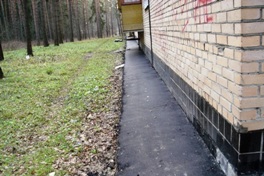
The base for a blind area made of asphalt concrete should be compacted with crushed stone (15 cm) or gravel with a size of 40-60 mm, pressed into the ground with a roller or tamping machine. An asphalt pavement (3 cm) is arranged on top.
The device of a blind area from asphalt concrete is quite difficult and this material cannot be called popular in private construction. In summer, when heated strongly, asphalt can soften and give off an unpleasant odor.
Crushed stone blind area

A crushed stone blind area is the cheapest option for covering. it perfect solution at a high level of groundwater and in the case when drainage is carried out around the building, since crushed stone facilitates the penetration of surface water. Instead of crushed stone, you can use gravel, pebbles, expanded clay. It is recommended to use the crushed stone fraction 8-32 mm.
A special geotextile material is laid on the rammed mainland soil, crushed stone is scattered on top of it - without filling from sand. Geotextile prevents coarse granules from mixing with the soil and preventing weeds from germinating. The thickness of the crushed stone layer is about 10 cm.
However, with an unorganized drainage from the roof (that is, when water does not flow down the gutters, but directly from the entire slope), the coating will have to be regularly corrected.
It should be borne in mind that granules of the same size cannot be tamped tightly, therefore, walking on them will be uncomfortable.



